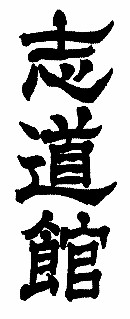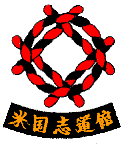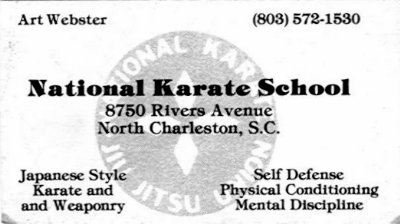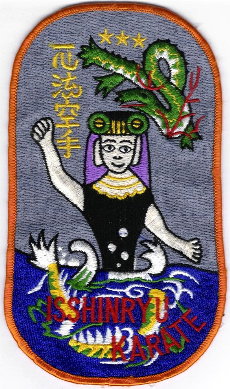


Shido Kan Shorin Ryu
Okay, many of you know, from my signature, that I'm a fan of Lawrence Kane. A number of months ago, he contacted me about a post I made on another martial arts board. He asked permission to use it in a book that he and Kris Wilder were writing. It's out! With my name and narrative included! The Way to Black Belt: A Comprehensive Guide to Rapid, Rock-Solid Results I have finished the first four chapters. I highly recommend it! The book will provide a great deal of insight into, not just into martial arts, but learning as well. Many business type concepts are included, enough to make this valuable for anyone even if they aren't martial artists!
I have been fascinated by the martial arts since I was very young. I can remember a couple of books in a collection that my father had at the library and what they showed. Kung Fu was a popular television show and then there was a teacher that talked about mind over matter and the ability to break boards. (Hey, Mr. Lyons, he was my General Science and Physics teacher!) But, the small town I lived in didn't offer any type of martial arts anywhere. I was too busy while in college to add another factor into my life, so that I was in the Navy before I could start doing something more then reading about this interest.
Tang Soo Do
The first style I took classes in was the Korean art of Tang Soo
Do. I went to the Chuck Norris Karate Studio in Virginia Beach. I remember a
Mr. Smith teaching there. I attended about 30 classes before the Navy transferred
me to Charleston, S.C. I passed my first test there in the summer of 1981 and
earned a yellow belt, 8th Kup if memory serves me correctly. I haven't been
able to locate my belt or my certificate, so I must have lost them in one of
my many moves. I do still have the white belt and I have some of the paperwork.
 |
Shotokan So after being transferred to Charleston, SC, I looked for another school. The closest to the apartment I had was in a store front in a strip mall. The Sensei was in his late 20's. The school was only open three nights a week and the heat was only on when we were actually in there. I remember pushing towels up and down the floor wiping up the condensation. I spent over 15 months at sea over the two years I was in Charleston and could attend only in small increments. Though I didn't earn any promotions, I learned the kata Tekki Shodan before my last class there in 1984. |
American Kempo Karate
It was about five years before I tried again. I took American
Karate in a studio in Livonia for about six months. I earned two promotions
here, getting two little stripes on the white belt, drawn on with a black Sharpie
by the instructor while you sat across the desk from him in the small office.
I still have that belt and no certificates were issued. Then I went and fell
in love and got married and moved, making it very hard to even try getting to
the studio.
|
Isshinryu A new school opened up in the strip mall across from the building I was working in. Well, it wasn't new, but it was a new location for the Southfield Martial Arts Institute which was under the direction of Sensei Willie Smith, an 8th Dan Black Belt. My new daughters were less than a year old and I had just finished my first year of law school. A lot of things happened over the next few months. We had an Au Pair come in to help take care of the twins. I almost lost my job while at the same time I was looking at the second year of Law School and the girls growing all the time. The Karate Dojo was a stabilizing factor and did a lot to keep me from being overwhelmed by the changes. After about a week the Au Pair asked me where I went all those evening, so I brought her along. She signed up that night and before she left at the end of the year, Manuella had earned her Green Belt, Fifth Kyu. I earned my first two stripes, Eighth and Seventh kyus, indicated with yellow plastic tape wrapped around the end of the belt. Once again I had some job changes and ended up working many miles away. Between law school and the distance, my contract elapsed and I didn't renew it. I did encounter one of the black belts, Mr. Smith, in law school. At one point his car was broken into and his sai was stolen. I had two sets, so I gave him one of mine. |
 |
Shido Kan Shorin Ryu

For Christmas 1999, my wife asked for a membership
in a health club. After checking out a number of places, I discovered
CMI. The facilities were pretty impressive, with both an inside
and outside pool, the outside one being key for the girls in the
summer. And, joy!, they had a dojo there.
Since January 3rd, 2000, I have been studying under Sensei
Robert Menders, now an 8th Dan in the Okinawan Style of Shido
Kan Shorin Ryu Karate. Of the various styles I have studied and
the variety of different schools, I like this one far better than
any of the rest. The group is fairly small, seldom more than a dozen
students at any one class. Most of the time the number of Black
Belts in the class out number the kyus. They pair up with us for
the one on one drills, which helps you learn quickly. Normally one
of the Black Belts works with us while the others work on the higher
level kata and bunkai. Everyone is friendly and it is more like
a family than anything else.
I have received a number of terrific benefits from participating.
The first that I noticed was that I was sleeping through the night.
A small thing, but one that has helped my overall health a great
deal. And I have lost weight! And the new friends are a great bunch
with a wide diversity of backgrounds.
The Hombu (home) Dojo of Shido Kan Karate in North
America is in Lansing. Hanshi Seikichi Iha is the 10th Dan that
is responsible for the style in North America. We run the 'ROYGBIV
Karate Bus' to Lansing every four to six weeks and attend class
there on a Saturday. The trip up is another way of getting to know
your fellow students. And the driver even provides reading material!
It is a lot of fun and very educational. Hanshi Iha has been very
gracious and is an incredible teacher. He will make you laugh at
yourself, certainly a better learning technique than any other,
driving the point home with a smile rather than a shout.
In December of 2005, CMI closed its doors and we
struggled to find a new place to meet. The main dojo moved to the
Lifetime Fitness Center in Commerce Township. Bob Menders teaches
there on Thursday nights. Dan Tabacaru teaches on Monday nights.
The Birmingham Dojo also offers Adult classes on Tuesdays and that
is where I currently train.

|
Shido Kan Shorin Ryu
|
|

|
For Christmas 1999, my wife asked for a membership
in a health club. After checking out a number of places, I discovered
CMI. The facilities were pretty impressive, with both an inside
and outside pool, the outside one being key for the girls in the
summer. And, joy!, they had a dojo there. |
|
The Hombu (home) Dojo of Shido Kan Karate in North America is in Lansing. Hanshi Seikichi Iha is the 10th Dan that is responsible for the style in North America. We run the 'ROYGBIV Karate Bus' to Lansing every four to six weeks and attend class there on a Saturday. The trip up is another way of getting to know your fellow students. And the driver even provides reading material! It is a lot of fun and very educational. Hanshi Iha has been very gracious and is an incredible teacher. He will make you laugh at yourself, certainly a better learning technique than any other, driving the point home with a smile rather than a shout. In December of 2005, CMI closed its doors and we struggled to find a new place to meet. The main dojo moved to the Lifetime Fitness Center in Commerce Township. Bob Menders teaches there on Thursday nights. Dan Tabacaru teaches on Monday nights. The Birmingham Dojo also offers Adult classes on Tuesdays and that is where I currently train. |
 |
My Black Belt Test
Naturally, I was awake long before the alarm clock went off. Nervous energy was already coursing through me. I got up and made coffee and made sure that my bags were packed. I shook my daughter awake and sipped my caffeine while waiting to leave. We got out the door allowing two and a quarter hours for the 75 mile trip. I was worried that construction and rush hour traffic might really slow us down, but I set a new record covering the 74 miles in 68 minutes. Liz read passages from the new Harry Potter book (we had both already finished it) out loud as we traveled, helping take my mind off what was waiting for me at the end of the trip. I had postponed my test for black belt several times due to a combination of nerves and feeling less than ready. It still took almost twenty minutes to get parked and into the testing building, construction making travel over the familiar routes impossible. Lots of friendly faces greeted me, wishing me luck as I changed. The test was in the Dance Studio, hardwood floor, the varnish was just old enough to allow us to pivot fairly well. Most of the individuals stretching out and warming up where unfamiliar to me. Ages ranged from teenagers to several that were older than me.
I discovered that there were nine applicants for Shodan, first degree black belt. The other thirteen were going for higher dan rankings. I heard a variety of accents, but it wasn’t until later that I learned that there were candidates from the Israeli dojo, one from Dallas, several from Canada, California, Missouri, New York and New Jersey. Unlike previous summer test sessions, and to the relief of many of us, the exam was closed, no spectators allowed. Joe, the towering 6 foot 6 inch 6th Dan, came in and explained the process to us. The exceptions were discussed (those that for various issues had certain items waived, such as bowing in seiza to the judges, or a shoulder injury that was going to prevent a roll in bunkai).
And then came the first anxious moment. The kata for the test were selected. These choreographed combinations of blocks punches, kicks and transitions are the heart of traditional karate training and were the most critical part of the testing. Chinto kata was a given. But which of the two Passai kata? Which of the two Kusanku? Which kata was best was going to depend on the individual. Different sized people, their flexibility, muscle build and stamina would all factor on which of the choices an individual preferred. I didn't have a real preference on Passai, Matsumura Passai was selected. I had been given a good deal of help on this kata by Iha Sensei on my last session working with him. I knew that if I showed him I remembered what he had corrected, that it would be good. Kusanku Dai! I broke into my first smile of the day. Whew! I liked the kata and I was more comfortable with it then the jump in Kusanku Sho, I was never happy with my landing.
There were twelve judges. Sensei Iha, the North American Grand Master and 10th Degree Black Belt, an 8th Degree, a whole panel of 7th Degrees (including my sensei) and a few 6th and 5th degree black belts. There were about eight others observing, the instructors of the candidates. Our names were read out in the order we were to line up in. First by rank being tested for and then alphabetically. I was number eight of the nine. I wasn't sure if that was good or bad, but decided afterwards that it was good for my nerves. We were told that we would be doing kumite with the partners in order. I introduced myself to number seven, a young lady whose name I recognized as being a member of one of the key families in the east coast. I was glad she was about my height, we wouldn't have to deal with adjusting the techniques to compensate for differences.
Sensei Iha arrived, tired from his return from Okinawa the night before. His mother had passed away ten days earlier and he had been at the funeral. Grading sheets were passed out to the judges and the test got underway. We started with the kata. The second or third candidate totally messed up his first kata, but moved into the second and third quickly and correctly. We had been told that if that should happen, we would be given the opportunity to do one kata over again. But watching the others do the kata allowed me to realize that everyone of them did it slightly differently. I gave me a comfort level that was a big help when my turn came. I don't remember much about my turn. I know that I did them. I sat down, relieved that I had made it through the kata without any major errors or mistakes. I had a few slight balance issues and a very small hesitation that my sensei recognized. As I watched the following individuals do their sequences, I tried to remember whether I had actually done the move in my turn, but couldn't! I was assured during the break by one of my fellow karateka that I had done them all. And I wasn't asked to do any of them over! The higher ranks testing were truly amazing to watch, particularly the two highest participants. There was a huge difference between the level of abilities from us lowly Ikkyu going for Shodan and the Yodans testing for Godan.
Before we moved into kumite, the one kata was redone. He did it correctly and looked good. It wasn't an issue, as he passed. Some styles would consider a kata mistake like this as an immediate and automatic fail. But we also have to balance the decision against reality. While nerves are an issue, how fair is it when someone has given up a month's salary to fly half way around the world? If someone messes up all of their kata, or their mind completely slides into vacation mode during bunkai, they will fail. We moved into the kumite. We were paired off, and I found myself paired off as expected. We ended up in the front row of the pairs, closest to the judges. We bowed to our partners and on command, went through the six sequences, one side only. It went quickly and we didn't have any flubs, the falls coming easy and the flow was crisp. I was actually pleased as we sat down and began to feel some confidence that I was going to pass. The bunkai set up was the first five candidates in position, with the rest of us lined up. We were to do the bunkai for Pinan Shodan, Pinan Sandan and Pinan Yodan. As each person finished, they rotated to the back of the line and the next one stepped into the rotation. I did fairly well, nothing omitted or forgotten, the falls all looked good as each uke dropped on contact to make everyone look as good as possible. Upon finishing the twenty-two sets of three, I was hoping we were done. I was sure that the carillon on campus had already struck noon, and the test was supposed to be done at 11.
But no rest, we lined up and were directed to perform the bunkai for Matsumora Bassai. I was not happy, as I know it is one of my weaker bunkai. I flubbed the first attackers position, missing a high low combination, but the person in the center adjusted well and we finished the sequence without looking too awkward. It was my biggest concern as we finished up. After bowing to the judges we were dismissed with a "We'll let you know!" I found my daughter and we headed out to grab some lunch. We had a half hour before the Seminar was to start. I was tired, but feeling fairly good. I got word almost immediately that one individual had not passed, and a little while later heard of another. They had done the kata properly as to the moves, but they had been hesitant lacking in power, flow and focus. I found out later that of the nine candidates for Shodan, six had passed.
After some great afternoon sessions lead by Sensei Iha, a kobudo demonstration and dinner, my daughter and I participated in the kobudo class. After about an hour we realized that we were both too fried to go on without endangering someone. She waited while I climbed the stairs to get our stuff and say good night to our dojo mates. I was 'strongly advised' by one of my instructors that I needed to hang around. I went and got my daughter and we lined up with everyone there for the final closing bow of the evening, only they made the announcements of the test results before dismissing us for the night. Those that passed were called up front. When my name was called I went forward to a chorus of cheers from throughout the gymnasium. Bowing to Sensei Iha, I was directed to take off my obi, and my Sensei proceeded to tie a black belt around my waist. It was a real thrill to walk down the line of the judges and instructors, bowing to all, hugging some. And then to join my fellow new shodans at the back, congratulating each other.
Fellow karateka, people that I had trained with over the years congratulated me over the next few days, but the most amazing part of the whole experience was this realization: Sometime after completing the kata portion of my test, I looked across the panel of judges. I knew everyone of them by name, and knew most of the other instructors that were watching their students. Over the past five years I had participated in at least one training session with each of them, many of them many times. I could even recall what some of them had helped with, a particular move on a kata, a stance, or a tricky transition. It is a real feeling of amazement to realize how much each of these people has become a part of me. I can only hope that sometime in the future, that I can share that part of these unselfish people with others that are behind me on the path.
For Photos - Black Belt Test
Kata – A sequence of moves representing blocking attackers and counter moves against them. The history is long and diverse, representing a teaching method hundreds of years old.
Bunkai – Application of kata while actual attackers come in against the center person. Teaches timing, distance and cooperation.
Kumite – Partner drills that teach timing, distance, cooperation, balance and calmness.
Ikkyu – First kyu, the level right below Black Belt. Depending on style, this is indicated by a brown belt, or a brown belt with black stripe, or black tips on the end.
Yodan – 4th degree black belt.
Godan – 5th degree black belt.
Sensei – “One who has gone before.” Usually refers to a teacher or a senior practitioner in any skill.
Karatedo – Literally translates as “Art of the empty hand.”
Kobudo – (or kobu jutsu) The art of the ancient weapons of Okinawa such as the bo, tonfa, sai or nunchuku.
Visit Sensei Iha's web site to learn more about Shido Kan Karate at Iha Dojo. There are links here to other dojos across the country. The St. Louis one has good history of the Shido Kan style, its origins and lineage, as well as Karate in general.
|
Cane Masters The Canemaster system teaches a wide variety of exercises and stretches using the cane. There are also numerous techniques for self-defense using the cane. I was tested as a Red Belt with the cane. Right - Myself with Grandmaster Mark Shuey and 'Pruning Mantis' a martial artist that I know from a web forum, as well as this seminar. |
Mark As a Kid | United States Navy Days
The last update to the page was on October 10, 2010
